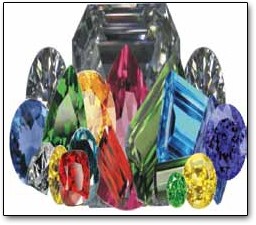The Same, But Different

By Gwen Myslinski
Sapphires, emeralds, rubies and diamonds — all gemstones that usually form below the Earth’s surface where they stay, patiently waiting to be discovered and potentially cut and polished for a stunning piece of jewelry.
Jewelers no longer have to wait for miners to unearth the precious or semiprecious gems to create spectacular pieces. Now they can turn to scientists for exquisite gems that have the same appearance and chemical structure as the natural ones, but can be produced in months or even days. Yes, there are a few small differences, according to James Shigley, a geologist at the Gemological Institute of America in Carlsbad, California:
- Natural gems contain small amounts of water, where lab-grown gems do not
- Certain lab-grown gems could hold traces of platinum that a natural gem would not have
- Oftentimes natural gemstones will have more inclusions than the lab-grown counterparts because the scientists can control the growth conditions
Extraordinarily Ordinary
Lab-made gems aren’t just for glitz and glam. They have many extraordinary uses, or really, ordinary uses. Who would have thought that a local supermarket could use a lab-grown sapphire in the check-out scanner? When the cashier scans the product, the laser shines through the hard and scratch-resistant sapphire plate. Talk about a blue-plate special.
Create a laser beam with lab-made rubies? Yep, and these lasers will even help remove certain colors of tattoo dye in a person’s skin. (Note: Do not try this at home.) Place a ruby rod in between two mirrors and flash an extremely intense light at the rod. The ruby will shoot out a beam of red light.
The most useful lab-grown gem is the diamond because it is so hard. It has been used to cut rock and drill for oil; it’s even been added to the tips of some dentists’ drills to help remove tooth particles. Now John Carlisle, a physicist and chief technical officer at Advanced Diamond Technologies Inc. is looking to take its usefulness even further by replacing a cell phone’s acoustic filter with a diamond filter so the battery will last longer.
“These diamonds could also be used in devices that help blind people see, in radar equipment for the military and in advanced computers for sending secret information that can’t be decoded. There’s just 101 uses for it,” said Carlisle.
Classroom Discussion
- What one element and how many atoms of that element make up a diamond?
- What is the cost difference between lab-grown and mined gemstones?